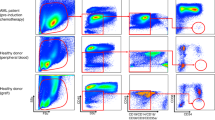Abstract
Sera from nine men and one woman having the recently described acquired immunodeficiency disease syndrome (AID) were studied for effects on healthy control lymphocyte activationin vitro by two T-lymphocyte activators, phytohemagglutinin (PHA) and allogeneic lymphocytes in the mixed lymphocyte culture (MLC) reaction. Selected sera were also tested for blocking of endogenous natural killer (NK) activity against the K562 tumor target. The results obtained demonstrated that all of the sera tested had a strong capacity to block the normal T-cell response and that this blocking effect could be diluted out. Some of the sera blocked α-interferon (αIFN)-induced NK activity but not endogenous NK activity. All of the patients had abnormal lymphocyte responses to T-cell activators in pooled normal human serum-supplemented cultures. There was no simple correlation between patient lymphocyte deficiency and percentage blocking capacity of patient serum. Sera were absorbed against sheep red blood cells (SRBC) and against allogeneic cells. SRBC absorption was effective in removing serum factors blocking normal lymphocyte responses to PHA and, in some cases, to allogeneic cells, whereas allogeneic absorption did not prevent serum inhibition of the PHA response. Conversely, allogeneic absorption removed serum factors blocking normal responses in MLC at least as well as or better than SRBC absorption. Increasing the number of absorptions increased the efficacy of allogeneic absorption. The positive effect of allogeneic absorptions was observed only when the stimulating allogeneic cell pool in the MLC was the same pool as that used in absorptions. The results suggest that both anti-T lymphocyte- and anti-major histocompatibility complex (MHC)-linked determinants are present in the sera of patients with AID. The implications of these findings are discussed.
Similar content being viewed by others
References
Masur H, Michaelis MA, Greene JB, Onorato I, Vandestouwe RA, Holzman RS, Wormser G, Brettman L, Lange M, Cunningham-Rundles S: A community-acquired outbreak ofPneumocystis carinii pneumonia—initial manifestation of cellular immune dysfunction. N Engl J Med 305:1531–1438, 1981
Siegal FP, Lopez F, Hammer GS, Brown AE, Kornfeld SJ, Gold J, Hassett J, Hirschman SZ, Cunningham-Rundles C, Adelsburg BR, Parham DM, Siegal M, Cunningham-Rundles S, Armstrong DA: Severe acquired immunodeficiency in male homosexuals manifested by chronic perianal ulcerative Herpes simplex lesions. N Engl J Med 305:1439–1444, 1981
Centers for Disease Control:Pneumocystis pneumonia—Los Angeles 1981. Morbid Mortal Week Rep 30:250–252, 1981
Gottlieb MS, Schroff R, Schanker HM, Weisman JD, Fan PT, Wolf RA, Saxon A:Pneumocystis carinii pneumonia and mucosal candidasis in previously healthy homosexual men: Evidence of a new acquired cellular immunodeficiency. N Engl J Med 305:1425–1431, 1981
Masur H, Michelis MA, Wormser GP, Lewin S, Gold J, Tapper ML, Giron J, Lerner CW, Armstrong D, Sefia U, Sender JA, Siebken RS, Nicholas P, Siegal FP, Cunningham-Rundles S: Previously healthy women with opportunistic infection as the initial manifestation of a community acquired cellular immunodeficiency: Extension of an emerging syndrome. Ann Intern Med 97:533, 1982
Goedert JJ, Newland C, Wallen WC, Greene MH, Mann DL, Murray C, Stong DM, Frameni JF, Blattner WA: Amyl nitrite may alter T lymphocytes in homosexual men. Lancet 1:412–416, 1982
Fauci AS: The syndrome of Kaposi's sarcoma and opportunistic infections: An epidemiologically restricted disorder of immunoregulation. Ann Intern Med 96;77–779, 1982
Cunningham-Rundles S, Hansen JA, Dupont B: Lymphocyte transformation to mitogens and antigens.In Clinical Immunobiology, Vol 3, F. Bach, RA Good (eds). New York, Academic Press, 1976, pp 151–194
Cunningham-Rundles S, Filippa D, Antonelli P, Ashikari H, Good RA: Natural killer cell activity of peripheral blood and regional lymph node lymphocytes in breast cancer. J Natl Cancer Inst 67:585–590, 1981
Cunningham-Rundles S, Bockman RS, Rubin BY: Modulation of natural cytotoxicity of T cell colonies and PBL by interleukin-2.In Natural Cell-Mediated Immunity, RB Herberman (ed). (in press), 1982
Hurtenbach U, Morgenstern F, Bennett D: Induction of tolerancein vitro by autologous murine testicular cells. J Exp Med 151:827–838
Friedman-Kein AE, Laubenstein LJ, Robenstein P, Buimovici-Klein E, Marmor M, Stahl R, Spigland I, SooKim K, Zalla-Pazner S: Disseminated Kaposi's sarcoma in homosexual men. Ann Intern Med 96:693–700, 1982
Morris L, Distenfeld A, Amorosi E, Kapatkin S: Autoimmune thrombocytopenia purpura in homosexual men. Ann Intern Med 96:714–717, 1982
Zinkernagel RM, Doherty PC: MHC-restricted cytotoxic T cells: Studies on the biological role of polymorphic major transplantation antigens determining T cell restriction, specificity, function and responsiveness. Adv Immunol 27:51–178, 1979
Pollack MS, Safai B, Myskowski PL, Gold JWM, Pendey J, Dupont B: Frequencies of HLA on immunogenetic markers in Kaposi's sarcoma. Tissue Antigens (in press), 1982
Prakash C, Coutinho A, Moller G: Inhibition ofin vitro immune responses by a fraction from seminal plasma. Scand J Immunol 5:78–85, 1976
Carney WP, Rubin RH, Hoffman RA, Hansen WP, Healey K, Hirsch MS: Analysis of T lymphocyte subsets in cytomegalovirus mononucleosis. J Immunol 126:2114–2116, 1981
DeWale M, Thielemans C, VanCamp BKG: Characterization of immunoregulatory T cells in EBV-induced infectious mononucleosis by monoclonal antibodies. N Engl J Med 304:460–462, 1981
Wallace LE, Moss DS, Rickenson AB, McMichael AJ, Epstein MA: Cytotoxic T cell recognition of Epstein-Barr virus-infected B cells. II. Blocking studies with monoclonal antibodies to HLA determinants. Eur J Immunol 11:694–699, 1981
Sethi KK, Stroehamann I, Brandes H: Human T cell cultures from virus sensitized donors can mediate virus specific and HLA-restricted cell lysis. Nature 286:718–720, 1980
Law HY, Bodmer W: Use of microimmobilization and microagglutination assays for attempted detection of HLA antigens and B2 microglobulin on human sperm. Tissue Antigens 12:249, 1978
Nelson DS, Gatti RA: Humoral factors influencing lymphocyte transformation. Prog Allergy 21:261–341, 1976
Shearer GM, Hertenbach U: Is sperm immunosuppressive in male homosexuals and vasectomized men? Immunol Today 3:153–154, 1982
Author information
Authors and Affiliations
Rights and permissions
About this article
Cite this article
Cunningham-Rundles, S., Michelis, M.A. & Masur, H. Serum suppression of lymphocyte activationin vitro in acquired immunodeficiency disease. J Clin Immunol 3, 156–165 (1983). https://doi.org/10.1007/BF00915487
Accepted:
Issue Date:
DOI: https://doi.org/10.1007/BF00915487




